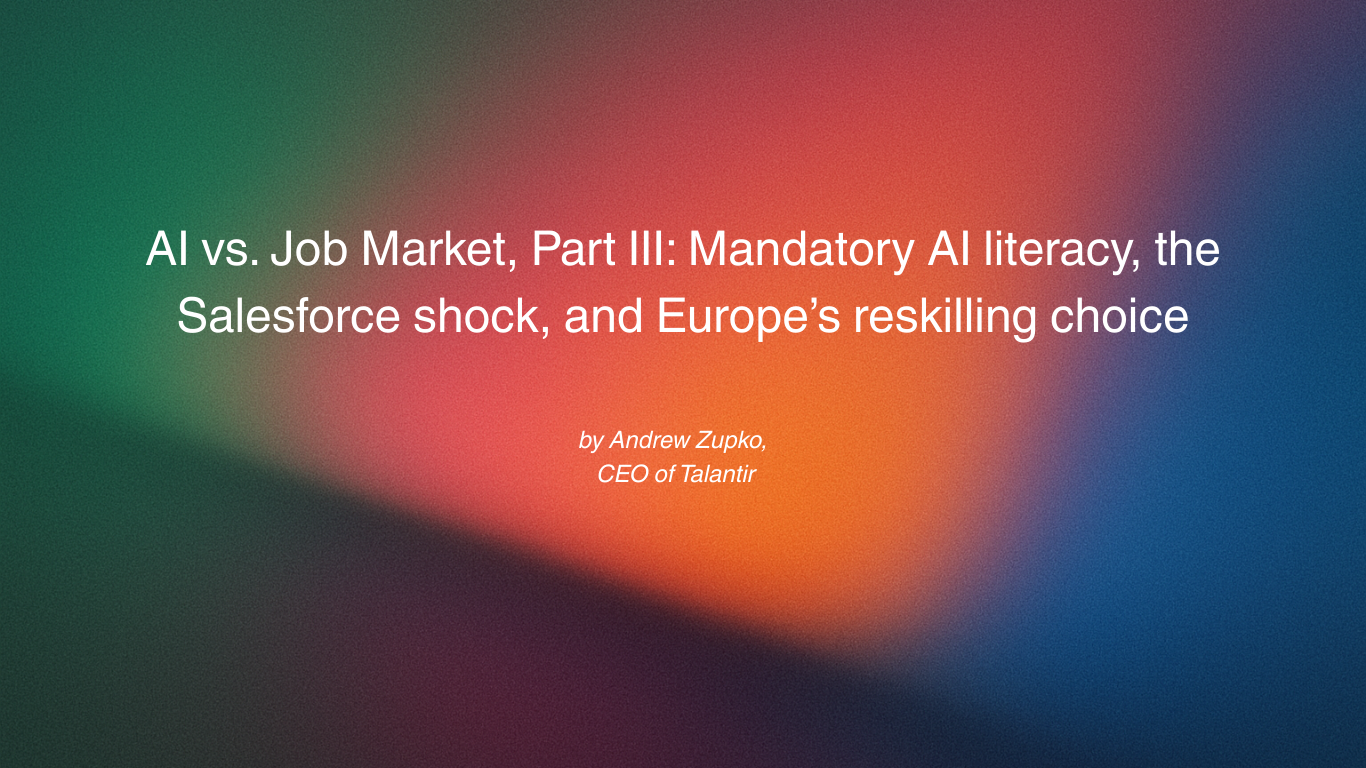If Parts I–II were about building evidence, Part III is about building capacity. Who learns fast enough, who gets left behind, and what we actually do when productivity outpaces available work.
China’s bet: make AI literacy mandatory
China isn’t waiting for the market to sort it out. National guidance in late 2024 pushed primary and secondary schools to expand AI instruction; in 2025 Beijing specified at least eight hours of AI courses per year across grades, with hands-on modules and privacy basics. Hangzhou went further, making AI compulsory across its schools, explicitly to grow a pipeline and upskill teachers. The logic is simple: future competitiveness rests on a broad floor of AI-capable citizens, not a thin layer of experts. State Council of China
The Salesforce shock: automation lands in customer support
The “future” is already landing unevenly. Salesforce’s CEO said this month the company cut about 4,000 customer support roles as AI agents took over routine tickets—while continuing to hire for AI-building jobs. Separate reporting earlier in the year also flagged smaller layoffs tied to the shift. Whatever your view of the decision, it’s a clean example of how one large employer can reduce headcount in exposed functions and expand it elsewhere. Yahoo Finance
Two realities can be true at once: well-designed AI tools raise frontline productivity (the Stanford/MIT call-center study showed a 14% average gain, most for novices), and managers will sometimes bank those gains as fewer roles. Skills—and how fast workers can redeploy—decide whether that’s a promotion, a pay bump, or a pink slip. siepr.stanford.edu
The cost of AI-illiteracy
Being AI-illiterate won’t just slow careers; it can shrink them. The IMF estimates around 40% of jobs globally are exposed to AI; in advanced economies, exposure skews higher, with risks of polarization if complementary skills aren’t spread widely. OECD’s workplace research adds the human layer: where training and worker consultation are weak, AI adoption is more likely to erode autonomy, amplify bias, and widen the digital divide. In short—without basic literacy, workers can’t supervise or safely leverage the systems now touching their jobs.
Europe’s question: after productivity, what about people?
Europe has a different toolkit than the U.S., and it matters when whole task-clusters get automated.
First, buy time to transition. Short-time work schemes (Germany’s Kurzarbeit and the EU’s pandemic-era SURE framework) preserved jobs by sharing hours instead of cutting heads, buffering household income while companies retooled. That approach is reusable for AI shocks—temporary work-sharing during retraining, not permanent exits. European Central Bank
Second, fund reskilling at scale. The Pact for Skills now counts millions trained and large-scale partnerships pledging 25+ million more by 2030; ESF+ brings triple-digit billions to local training and inclusion; Digital Europe finances advanced digital skills and AI capacity. These aren’t pilots; they’re the rails we already have.
Third, experiment with work-time where tasks truly compress. The UK’s four-day-week pilots found stable or improved productivity with sharply better retention and lower burnout; Spain is moving toward a shorter statutory week. This won’t fit every sector, but as AI trims routine work, time-based redesign is a pragmatic lever alongside job redesign.
Put bluntly: Europe can absorb productivity by sharing it (work-time), redeploy people with funded training (Pact/ESF+/Digital Europe), and smooth shocks with short-time work—if we connect these instruments to real, verifiable skill gains.
How we handle this at Talantir
We built Talantir for exactly this transition.
- Floor of literacy, fast: every role track starts with a 4–6 hour “AI-basics for your job” micro-module (prompts with intent, evaluation, simple automations, safety). No jargon; hands on.
- Proof-first upskilling: learners don’t just “watch and quiz.” They ship small artifacts—prompts, code, decision memos—scored against transparent rubrics, so an ESCO-mapped micro-credential is more than a badge.
- Redeploy, not discard: for teams facing automation, we run redeployment sprints: map current tasks to adjacent AI-complementary tasks (e.g., from tier-1 support to QA of AI outputs; from reporting to data hygiene and eval), then certify with portable credentials employers can trust.
- Public rails by default: every outcome exports as an EDC-ready credential and works with EBSI-conformant wallets, so people carry proof into LinkedIn, ATSs, or public employment services without living inside our product.
The takeaway
China is moving first on population-level literacy. U.S. giants are already showing what task-level automation looks like in the wild. Europe’s advantage is infrastructure—funding, protections, and credential rails. If we fuse them with proof-based upskilling, we can turn productivity into better jobs, not fewer futures.
FULL REPORT OF TALANTIR TEAM HERE
